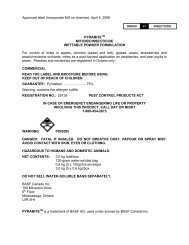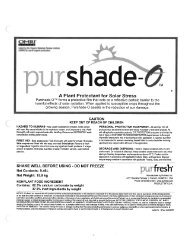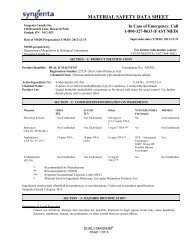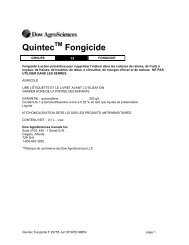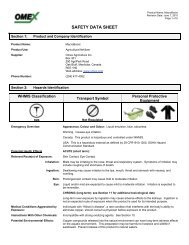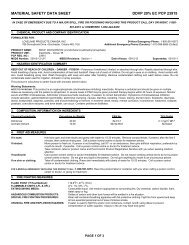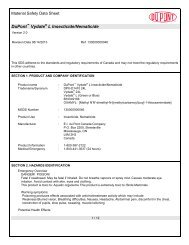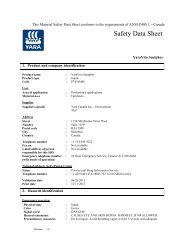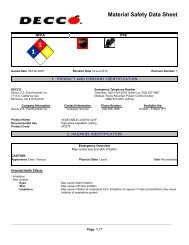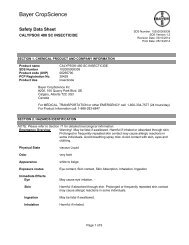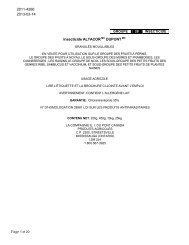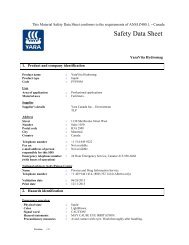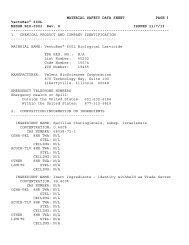Hydrochloric Acid msds english.pdf - Bartlett.ca
Hydrochloric Acid msds english.pdf - Bartlett.ca
Hydrochloric Acid msds english.pdf - Bartlett.ca
You also want an ePaper? Increase the reach of your titles
YUMPU automatically turns print PDFs into web optimized ePapers that Google loves.
<strong>Hydrochloric</strong> <strong>Acid</strong>, 30 - 40 %WHMIS Number : 00060172Page 4 of 9Containment and Clean-UpProcedures:Brenntag Canada Inc.Date of Revision: 2011 January 10See Section 13, "Deactivating Chemi<strong>ca</strong>ls". In all <strong>ca</strong>ses of leak or spill contact vendor at EmergencyNumber shown on the front page of this MSDS. Wear protective clothing. Do not use combustiblematerials such as sawdust as an absorbent. Spilled acid may <strong>ca</strong>use floors and contact surfaces to become slippery. Collect product for recovery or disposal. For release to land, or storm water runoff,contain discharge by constructing dykes or applying inert absorbent; for release to water, utilizedamming and/or water diversion to minimize the spread of contamination. Ventilate enclosed spaces.Notify appli<strong>ca</strong>ble government authority if release is reportable or could adversely affect the environment.7. HANDLING AND STORAGEHANDLINGHandling Practices:Ventilation Requirements:Other Pre<strong>ca</strong>utions:STORAGEStorage Temperature (°C):Ventilation Requirements:Storage Requirements:Special Materials to be Used forPackaging or Containers:Use normal "good" industrial hygiene and housekeeping practices. Containers exposed to heat may beunder internal pressure. These should be cooled and <strong>ca</strong>refully vented before opening. A face shield andapron should be worn. When diluting, add this material/product to water in small amounts to avoidspattering. Never add water to this material/product. Add small quantities of this material slowly to largequantities of water, stirring constantly all the while. Constant stirring is necessary to avoid concentrationof the product at the bottom of the mix vessel. Such concentration of the product may result in a violentexotherm with boiling of the liquid resulting in splashing, spattering or a violent eruption of a highlycorrosive solution if the addition is too rapid or without sufficient stirring.See Section 8, "Engineering Controls".Use only with adequate ventilation and avoid breathing aerosols ( vapours or mists ). Avoid contact witheyes, skin or clothing. Wash thoroughly with soap and water after handling. Wash contaminatedclothing thoroughly before re-use. Do not use cutting or welding torches on empty drums that containedthis material/product.10 to 27 °C.Ventilation should be corrosion proof.Store in a clean, cool well ventilated area, away from organic chemi<strong>ca</strong>ls, strong bases, strong acids,metal powders, <strong>ca</strong>rbides, sulfides, and any readily oxidizable material. Protect from direct sunlight.Protect against physi<strong>ca</strong>l damage. Do not expose sealed containers to temperatures above 40 °C.Storage tanks should be in a contained area to control any spills or leaks. Storage area should beequipped with acid-resistant floors, sumps and should have controlled drainage to a recovery tank. Donot store or transport with food or feed.Materials of construction for storing the product include: karbate, Teflon, epoxy, ceramic, Pyrex, PVC,glass lined steel, Rubber lined steel.All metal equipment used to handle this acid must be lined with an appropriate protective material, suchas rubber or certain plastics. (3) Attacks some types of rubber, plastics and coatings. Confirm suitabilityof any material before using.Equipment for storage, handling or transport should NOT be made from the following material, or, whereappli<strong>ca</strong>ble, its alloys: nylon, zinc, brass, galvanized iron, bronze, steel, mild steel, stainless steel,aluminum or copper.8. EXPOSURE CONTROLS / PERSONAL PROTECTIONRecommendations listed in this section indi<strong>ca</strong>te the type of equipment, which will provide protection against overexposure to this product.Conditions of use, adequacy of engineering or other control measures, and actual exposures will dictate the need for specific protectivedevices at your workplace.ENGINEERING CONTROLSEngineering Controls:Corrosion resistant explosion proof lo<strong>ca</strong>l exhaust is acceptable for laboratory use. Forced ventilationneutralizing scrubber is required when large amounts are used in manufacturing. Use only in closedsystems which are corrosion resistant and are verified as being free of air and moisture at all times (evenwhen not in use). Pressure test and purge system prior to each use with inert gas. Air monitoring deviceis highly recommended. Make up air should be supplied to balance air that is removed by lo<strong>ca</strong>l orgeneral exhaust ventilation. Ventilate low lying areas such as sumps or pits where dense vapours maycollect.For personnel entry into confined spaces (i.e. bulk storage tanks) a proper procedure must be followed.It must include consideration of, among other things, ventilation, testing of tank atmosphere, provisionand maintenance of SCBA, and emergency rescue. Use the "buddy" system. The second person shouldbe in view and trained and equipped to execute a rescue. (4)



